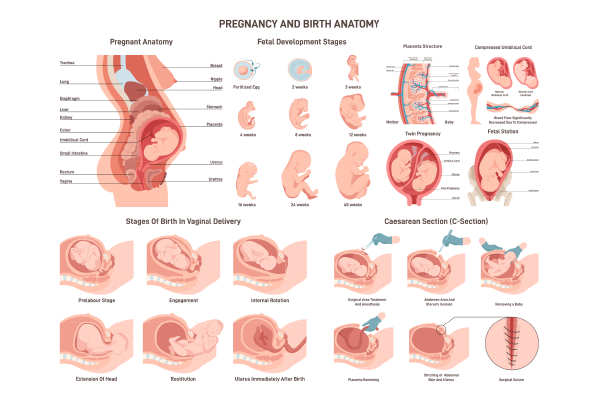
Recovering from a C-section delivery can be a challenging experience, but with proper care and attention, new mothers can heal well and regain their strength. This guide will cover essential information to help you navigate the recovery process with ease.
Synopsis
- Hospital Stay and Immediate Post-Surgery Care
- Managing Pain and Discomfort at Home
- Incision Care and Healing
- Diet and Nutrition for Recovery
- Physical Activity and Exercise
- Breastfeeding After a C-Section
- Emotional Well-being
- Sleep and Rest for Faster Recovery
- Follow-Up Appointments and Long-Term Care
- Common Challenges and When to Seek Medical Attention
- Conclusion
Hospital Stay and Immediate Post-Surgery Care
The first few days after a C-section are critical for ensuring proper healing.
Pain Management Techniques
During your hospital stay, your medical team will provide medication to manage pain. Epidural or spinal anaesthesia may still provide some relief for the first few hours. Post-surgery, oral medications will help manage discomfort.
Early Movement and Mobility
Doctors often recommend gentle movement within 24 hours to reduce the risk of blood clots. You may be assisted with sitting, standing, or walking small distances.
|
Do’s |
Don’ts |
|
Walk short distances to promote circulation |
Avoid strenuous activity or heavy lifting |
|
Use abdominal support when moving |
Do not strain the incision area |

Managing Pain and Discomfort at Home
Managing pain at home is vital for comfort and effective healing. Your healthcare provider may prescribe medications or suggest over-the-counter pain relief options like ibuprofen.
-
Positioning: Use pillows for extra support when sitting or lying down.
-
Breathing Techniques: Deep breathing exercises can help ease tension and pain.
-
Heat Therapy: Applying a warm compress can alleviate muscle soreness.
More Reads: C-Section Delivery: When Is It Necessary
Incision Care and Healing
Proper care of the surgical site is essential for preventing infection and promoting healing. Follow these tips:
-
Cleaning: Gently clean the area with mild soap and water. Pat dry.
-
Breathable Clothing: Wear loose, breathable clothing to avoid irritation.
-
Monitoring for Infection: Watch for redness, swelling, or unusual discharge.
|
Signs of Infection |
Action |
|
Increased redness or swelling |
Contact your healthcare provider |
|
Fever over 100.4°F |
Seek medical attention immediately |
Diet and Nutrition for Recovery
Nutrition plays a significant role in C-section recovery. Consuming nutrient-rich foods can accelerate the healing process.
-
Protein-Rich Foods: Include lean meats, eggs, and legumes to aid tissue repair.
-
Fruits and Vegetables: Rich in vitamins and fibre to prevent constipation.
-
Hydration: Drink plenty of water to stay hydrated and promote milk production.

Physical Activity and Exercise
Physical activity should be resumed gradually. Most doctors recommend waiting 6-8 weeks before starting any intense workouts.
-
Walking: A low-impact way to improve circulation and reduce swelling.
-
Pelvic Floor Exercises: Help strengthen muscles weakened during pregnancy.
-
Avoid Heavy Lifting: Strenuous activities should be postponed until cleared by your doctor.
More Reads: 7 Tips For Planning Your Pregnancy
Breastfeeding After a C-Section
Many mothers face challenges with breastfeeding after surgery. Finding the right position can help.
-
Laid-Back Position: Allows gravity to support the baby while minimizing pressure on the incision.
-
Football Hold: A side-hold position that keeps weight off the abdomen.
If you experience discomfort or latching issues, consider consulting a lactation expert for support.
More Reads: Preparing for Normal Delivery: What to Expect
Emotional Well-being
Emotional postpartum care is just as essential as physical healing. Hormonal changes, sleep deprivation, and the stress of new motherhood can lead to mood swings or baby blues.
-
Emotional Support: Surround yourself with a support system of friends, family, or counsellors.
-
Mindfulness Practices: Meditation and breathing exercises can help reduce anxiety.
-
Postpartum Depression: Seek professional help if you experience feelings of sadness, detachment, or overwhelming anxiety.
Sleep and Rest for Faster Recovery
Adequate rest is critical during C-section recovery. Prioritize sleep whenever possible:
-
Sleep When the Baby Sleeps: Take advantage of your baby’s nap times.
-
Ask for Help: Don’t hesitate to lean on others for chores and baby care.
-
Supportive Sleeping Positions: Lying on your side may reduce pressure on the incision.
Follow-Up Appointments and Long-Term Care
Your post-surgery follow-up appointment is crucial for monitoring healing. During this visit, your doctor will:
-
Check the incision site for proper healing.
-
Discuss any ongoing pain or discomfort.
-
Guide on when to resume regular activities.
Adhering to your doctor’s recommendations will help ensure a smooth recovery.
More Reads: 10 Benefits Of Normal Delivery
Common Challenges and When to Seek Medical Attention
Some complications that may arise during recovery include:
-
Excessive Bleeding: Contact your doctor if you experience heavy bleeding or large blood clots.
-
Breathing Difficulty: Seek emergency care if you have chest pain or trouble breathing.
-
Sudden Fever: A sign of infection requiring prompt attention.
Conclusion
Why Choose Manipal Hospitals Ghaziabad for Postpartum Care?
At Manipal Hospitals Ghaziabad, we offer comprehensive postpartum care for mothers recovering from a C-section. Our team of specialists provides personalized support for managing pain, incision care, and emotional well-being. With state-of-the-art facilities and experienced healthcare providers, you can rest assured that you and your baby will receive the best possible care.
For expert postpartum care and guidance on C-section recovery, book an appointment at Manipal Hospitals Ghaziabad today.
FAQ's
Most women take 6-8 weeks for full recovery, though healing time varies.
It’s generally safe to drive once you can brake suddenly without pain, typically around 2-3 weeks.
Light exercises, like walking, can start within a few days, but wait 6-8 weeks for more strenuous activity.
Redness, swelling, unusual discharge, and fever are signs of infection. Contact your doctor if these occur.
Build a support network, practice mindfulness, and seek professional help if experiencing postpartum depression.



















 5 Min Read
5 Min Read















